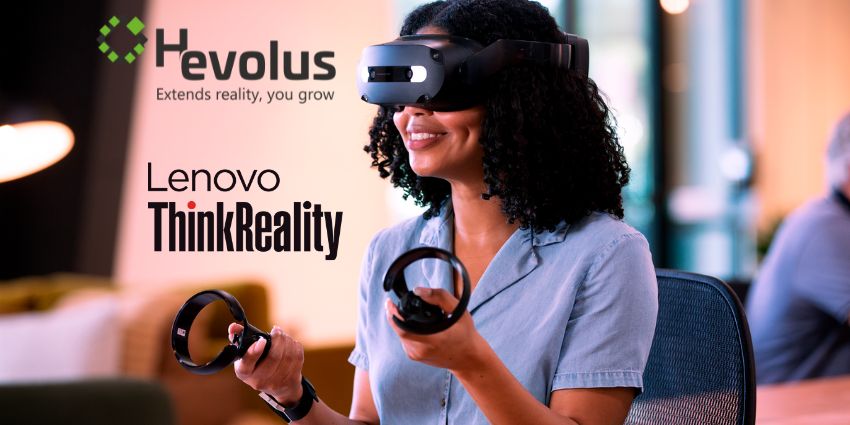Hevolus and Lenovo are making waves in the educational sector
Hevolus and Lenovo are making waves in the educational sector by integrating Extended Reality (XR) technologies with the Lenovo ThinkReality VRX headset directly in the classroom, transforming the traditional learning experience into an interactive and immersive journey. The collaboration between these two tech pioneers combines Hevolus’ innovative software and Lenovo’s cutting-edge hardware to create innovative educational tools that have both educators and students excited about the future of learning.
“Our XR solutions enhance education by merging immersive 3D holograms with the physical learning space, making lessons more engaging and memorable,” explained Hevolus CEO Fabio Santini. Transforming learning from a passive experience into an immersive journey, the approach “fosters social interaction between teachers and students, and deepens understanding and retention through emotional engagement and interactive experience,” he continued.
Straightforward deployment of XR in education
Integrating XR solutions into traditional educational settings was not without its challenges. Initially, there were concerns about how educators would adapt to using such advanced technology in their classrooms. “The XR technology we brought in was made to be easy to use, so teachers and students could get the hang of it without needing a lot of training,” Santini continued. By ensuring that the technology was user-friendly and giving teachers control over it, Hevolus effectively turned a potential hurdle into a significant advantage, enhancing the educational process.
The decision to partner with Lenovo and deploy the ThinkReality VRX was strategic. “Lenovo is a globally recognized company that has always prioritized customer success,” stated Santini. The synergy between Lenovo’s commitment to developing high-quality XR devices and Hevolus’ innovative educational solutions has enhanced the learning experience and added significant credibility to the initiative.
In particular the versatility of the technology means that the teacher can work with the ThinkReality VRX in pass-through mode, so they can observe first-hand the captivated attention of their students, even if they themselves are engaging with the VR content through a screen or a hologram – the solution does not require the upfront investment in high-end VR headsets for each participant.
Feedback from users has been overwhelmingly positive, highlighting a transformative shift in education. “We’re seeing a fundamental change in how education is delivered and received,” Santini continued. “This new approach to learning is not only more effective but also more enjoyable for both educators and students.”
Preparing a new generation for a “phygital” world
On Lenovo’s side, the commitment to education and the next generation of XR users is clear. “Educating students on modern technologies is crucial to bridge the skills gap, foster innovation, and expand the market,” said Stefano Mazzola, EMEA XR Solution Sales Executive.
The company sees its role in educating the future workforce as not just a business strategy but also a key opportunity to deliver on its promise of Smarter Technology For All. A digitally native generation will use these technologies every day in their future careers, so why should they learn about them from a slide presentation in the classroom? As Mazzola declared, “New technologies, such as XR, represent just another piece of the ever-evolving technological landscape. We are dedicated to helping students of all ages realize their aspirations and seize the opportunities of the XR future.”
Looking ahead, Hevolus envisions a future where XR technology plays a central role in education. Santini shared excitement about the emergence of a “phygital” reality, where the physical and digital worlds blend seamlessly, offering a more engaging and personalized learning experience powered by wearable XR technology and artificial intelligence. “People will start wearing smart glasses or lenses a lot, which will let us see computer images as if they are right in front of us. This will make learning more fun and a part of our daily life. Also, with the help of artificial intelligence (AI), talking to and learning from computer programs will be as easy as talking to our teachers or friends. Mixing wearable XR tech with AI will make learning more interesting, personal, and better.”
Together, Hevolus and Lenovo are setting a new standard for educational technologies. By harnessing the power of XR, they are revolutionizing the learning experience and preparing students for a future where technology and education are inextricably linked.
As this innovative approach to learning continues to unfold, it promises to open up new possibilities for educators and students alike, making education more accessible, interactive, and engaging than ever before.
Santini concluded, “this new way of learning will not only help us learn better, but also get us ready for a future where the real and computer worlds are mixed.” Blending the best of traditional learning theories with the latest XR technologies, Lenovo and Hevolus are delivering a future-proof education in the classroom today, and preparing a new generation for the enterprise environment of the future.
Quelle:



